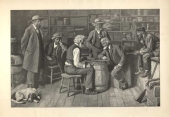The Checker Maven
The World's Most Widely Read Checkers and Draughts Publication
Bob Newell, Editor-in-Chief
Published every Saturday morning in Honolulu, Hawai`i
Noticing missing images? An explanation is here.
In the Grand Manner

Along with the Grand Old Game, there is little that is as wonderful as Grand Opera, performed by a truly world class company such as we are privileged to have here in Santa Fe.
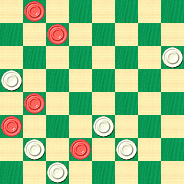
White
White to Play and Win
Just a word of caution: today's problem is "grand" in terms of difficulty as well as content. If you solve it, congratulations --- you might wish to reward yourself with a front row seat at the Santa Fe Opera!
[Read More]The Checker Maven is Looking for Stringers

Now, we know that up-to-the-minute tournament results and standings are generally posted on the Checker Solutions BBS (see link at left), or on specific websites. We're not looking to compete or "double up" in this area, and we're not looking to publish games, play, or analysis without proper permissions and clearances. We know that in a number of cases, game scores are kept in reserve for contributors.
However, having said all that, if you're in a position to provide us with timely news, play, or commentary from checker events, and doing so wouldn't be in conflict with what we've stated above, your contributions would be heartily welcomed. Full credit would be given, and in return you can have any share you want of our subscription fees. (Let's see, we learned in school that any number times zero is ....)
We hope to hear from you!
Welcome to Checker School
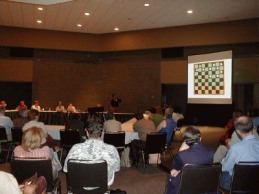
Let's get started with a delicate endgame of a very practical nature. Class is in session!
WHITE
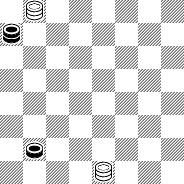
BLACK
Black to Play and Draw
Click on Read More for the solution, a runup to the position, and additional notes and quotes from Famous Positions.
(Editor's Note: the color diagrams will return as soon as we work through our article backlog.)
[Read More]Three Easy Strokes, Part Three
Here's the last of our "easier" stroke problems, at least in this series. Will you find this one to be a July cruiser, or something more? Solve it, check your solution by clicking Read More, and then prepare yourself --- next month's problem is going to be a summer scorcher.
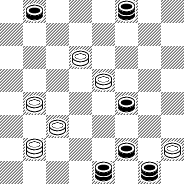
WHITE
White to Play and Win
Two Easy Pieces: Sixth Edition
Willie Ryan's classic Tricks Traps & Shots of the Checkerboard, presented here in a new electronic edition, is up to the sixth installment. Here's what Willie has to say on page 16 of the book.
BLACK
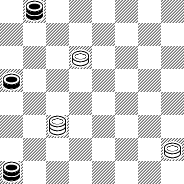
WHITE
White to Play and Win
BLACK
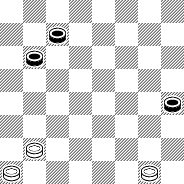
WHITE
White to Play and Win
You can check your solutions by clicking on Read More.
[Read More]Checker-Go-Round

Click on Read More to check your solutions.
(We are always in need of speed problems. If you have any that you'd like us to publish, please contact us using the contact link in the left column.)
Problem 1. Very easy.
Problem 2. Easy.
[Read More]Fifth Reprise: Two Easy Pieces
Here is the fifth installment of our continuing series from Willie Ryan's classic Tricks Traps & Shots of the Checkerboard. As always, we're here to listen to the man himself; click on Read More to check your solutions.
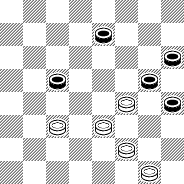
White to Play and Win
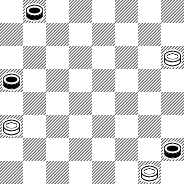
White to Play and Win
A Great Shot, But Can You Win The Ending?

On this "Anything Can Happen" Wednesday, we bring you a game played by guest author Ingo Zachos in a recent matchup on the It's Your Turn on-line game site. Capitalizing on an error by his opponent, Ingo finds a thrilling shot--- and then still has to demonstrate the win in the endgame! We've interspersed Ingo's own interesting comments and analysis with our own, which are due to running the world-class King's Row program at 15 minutes per move.
Ingo Zachos - Raymond Faircloth
It's Your Turn January 2005
with commentary by Ingo Zachos
1.11-15 23-18
2.8-11 27-23
3.4-8 23-19
4.10-14 19x10
5.14x23 26x19
6.6x15
I know 6.7x14 is the fashion, but I was inspired by Game 7 of the GAYP World Championship of 1956, Wiswell- Fraser, after reading International Checkers and Draughts.
6...19x10
7.7x14 24-19
8.11-16 31-26
Here Fraser played 8...19-15 and after 9.16-19 22-17 10.14-18 25-22 11.18x25 29x22 12.12-16 22-18 13.16-20 17-14 14.9-13 14-10 15.19-23 18-14 16.2-7 31-26 17.7-11 26x19 18.11x18 he played 19-16 and lost, thus: (18...32-27 19.18-22 19-16 20.8-12 16-11 21.12-16 28-24 22.22-25 21-17 23.13x22 30x21 24.22-26 21-17 25.26-31 10-7 26.3x10 14x7 27.1-6 7-3 28.6-10 3-7 29.10-15 7-10 30.16-19 27-23 31.19x26 10x19 32.20x27 19-23 is given by Dr. Fraser as drawn.) 19.18-23 16-12 20.8-11 10-7 21.3x17 21x14 22.1-6 12-8 23.13-17 8-3 24.17-21 3-8 25.23-27 8x15 26.6-9 32x23 27.9x27 28-24 28.27-31 24-19 29.20-24 15-18 30.24-28 19-16 31.28-32 18-22 32.32-27 16-12 33.5-9 22-17 34.27-23 12-8 35.23-19 8-3 36.19-15 3-7 37.31-27 7-2 38.15-10 17-22 39.27-23
9.16x23 26x19
10.8-11!?
10.9-13 trying to avoid the rapid advance of White's single corner side, is better, but I underestimated the power of the man on 15. (King's Row thinks any of 2-6, 1-6, 2-7, 8-11, 9-13, or 3-7 are about equal. --Ed.)
10...19-15
11.11x18 22x15
12.12-16
I also calculated 12.2-7 28-24! but there seemed to be equality with less chances of a tactical surprise. (The idea was the trick 12...15-10? 13.14-17 21x14 14.9x18 to a neat win.) 12.3-8?! would be a minor variation because of 15-10 and the piece on 10 is very disturbing. (In fact, Kings's Row agrees that 3-8 is weak. --Ed.)
12...15-11?!
13.14-17!?
Sometimes masters say they calculate 50 moves ahead. Well, here I already saw the final position of this game in my mind very clearly and knew it was won.
13.1-6 as indicated by the programs, might be better, but during the game I evaluated it as drawn.
(Editor's note: King's Row thinks 12. ... 15-11 is inferior, though not an outright loss, and prefers 30-26 or 25-22. But King's Row disagrees with our author over 13.14-17, rating the resulting position as a draw. As our author points out 1-6 is preferred but the game is still far from a win.)
13...21x14
14.9x18 30-26?
Believe it or not, this is already the fatal mistake.
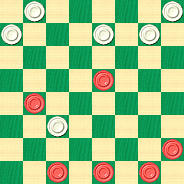
RED
Red to Play and Win
(Editor's note: let's pause here. Ingo is about to play an exciting shot. Can you spot it? And if you can, are you able to demonstrate the win after the shot is complete? When you've figured it out, click on Read More to see the rest of the game.)
[Read More]The Last of the Masked Men
Our Masked Man problem series draws to a close with this month's article. We hope you've enjoyed it. Perhaps we can run another similar series sometime in the future.
If you can identify the problemist in the photo below, you're doing really well at this sort of thing.

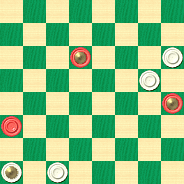
WHITE
White to Play and Win
Can It Be Done?
Check your solution by clicking on Read More. Intended to be of "medium" difficulty, this one packs a surprise. Even if you solve it easily, though, by all means read the commentary which accompanies the solution.
[Read More]Three Easy Strokes, Part Two
We continue again this month with our "summer light" series of easier-than-usual stroke problems with this offering for June, which is, as you will see if you figure it out, a bit mis-labeled. And be forewarned, after this series concludes it's back to the hard ones!
After you solve it click on Read More to check your answer.
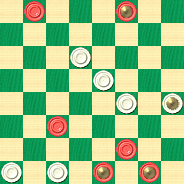
WHITE
White to Play and Win
The Checker Maven is produced at editorial offices in Honolulu, Hawai`i, as a completely non-commercial public service from which no profit is obtained or sought. Original material is Copyright © 2004-2025 Avi Gobbler Publishing. Other material is public domain, as attributed, or licensed under Creative Commons. Information presented on this site is offered as-is, at no cost, and bears no express or implied warranty as to accuracy or usability. You agree that you use such information entirely at your own risk. No liabilities of any kind under any legal theory whatsoever are accepted. The Checker Maven is dedicated to the memory of Mr. Bob Newell, Sr.

